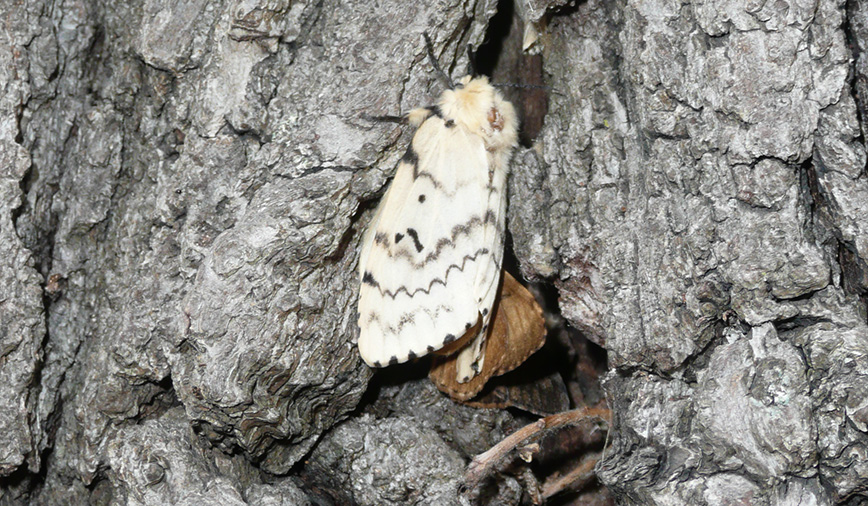I ran into a gypsy again the other day, and I wasn’t happy about it. Don’t get me wrong—human gypsies seem pretty cool, and I really wouldn’t mind meeting one of them. The gypsy I’m talking about, though, is Lymantria dispar, the gypsy moth, an imported insect with a penchant for feasting on forests.
I first encountered these little buggers back in May when, as teeny-tiny larva, they were raining down on the deck and railings at Tekakwitha Woods Forest Preserve. The nature program staff there was doing their part to stem the tide, crunching and scrunching the small, dark caterpillars at every chance, but the gypsy moths had done their part too, and their young continued to appear.
Last week, the gypsies came calling again, this time disguised as a gift from our summer camp kids at LeRoy Oakes. Knowing I was doing a program on insects, the campers in Miss Kim and Miss Lynn’s class proudly presented us with a jar with not one but two large caterpillars inside. The critters were hairy, with five pairs of blue dots and six pairs of red dots along their back—the distinctive markings of a juvenile gypsy, pre-pupation.
Later, a scan of the Norway maple tree where they were found revealed the remnants of a gypsy moth egg mass but no more caterpillars. Thinking optimistically, maybe the two caterpillars the kids found were the only ones that survived, and we’ve made sure they’ll not return to the wild. Thinking pessimistically, it could be that the caterpillars simply had wandered down and disappeared for the day, a common behavior and the one that led to the insects earning the name “gypsy.” Or, perhaps the caterpillars had entered pupation and will soon emerge as moths, ready to start the next voracious generation.
Then there was this week. I was leaving a meeting we’d had with the park district’s marketing department, which is headquartered in a house just west of the Baker Community Center on Walnut St., when a white blob on an oak tree caught my eye. Hoping against hope that it was just a marshmallow smushed against the bark, I walked over for a closer look and saw…a female gypsy moth heavy with eggs, clinging to the tree. Worse, there was a male close by. Very close by, if you get what I mean.
Just above that pair, another white blob was busy churning out eggs. A third female was similarly engaged higher up, just out of reach. And a fourth was on a branch 6 feet over my head, probably emanating pheromones, while a hormone-charged male fluttered nearby.
There’s no doubt, the gypsies are in St. Charles. And they’re here to stay.
The insects we’re seeing today are descendants of a group brought here from Europe in the late 1860s, part of a well-intentioned but misguided mission to breed a hardier silkworm. The moths escaped their confines in Medford, Mass., and have been munching leaves and marching west ever since.
Their arrival in northeastern Illinois several years back was greeted with monitoring efforts, quarantines and control programs—namely low-flying helicopters dropping the caterpillar-killing bacterium Bacillus thuringiensis ‘Kurstaki’ or BtK. Another program called Slow-The-Spread uses integrated pest management to help keep the moths in check. Here in the Prairie State, such efforts are aided by our large expanses of farmland. These “corn deserts” provide little in the way of host plants for the gypsies, and may help control their advancement.
What should you do if you think you’ve found gypsy moths in the trees on your property? Barbara Bates, horticulture educator at the University of Illinois Extension, Kane County Unit, recommends contacting a certified arborist if the infestation seems severe or if your trees appear stressed. But if you’re just seeing egg masses, take a knife and scrape them into a bucket of soapy water. You’ll be preventing next year’s caterpillars from hatching. And as for those pesky caterpillars and plump adults, Bates’ advice is even simpler—and fun, in a primal sort of way. Put on your garden gloves, grab the little grubbers and, she says, “Just squish ’em.”
Pam Otto is the manager of nature programs and interpretive services for the St. Charles Park District. She can be reached at potto@stcparks.org or 630-513-4346.

